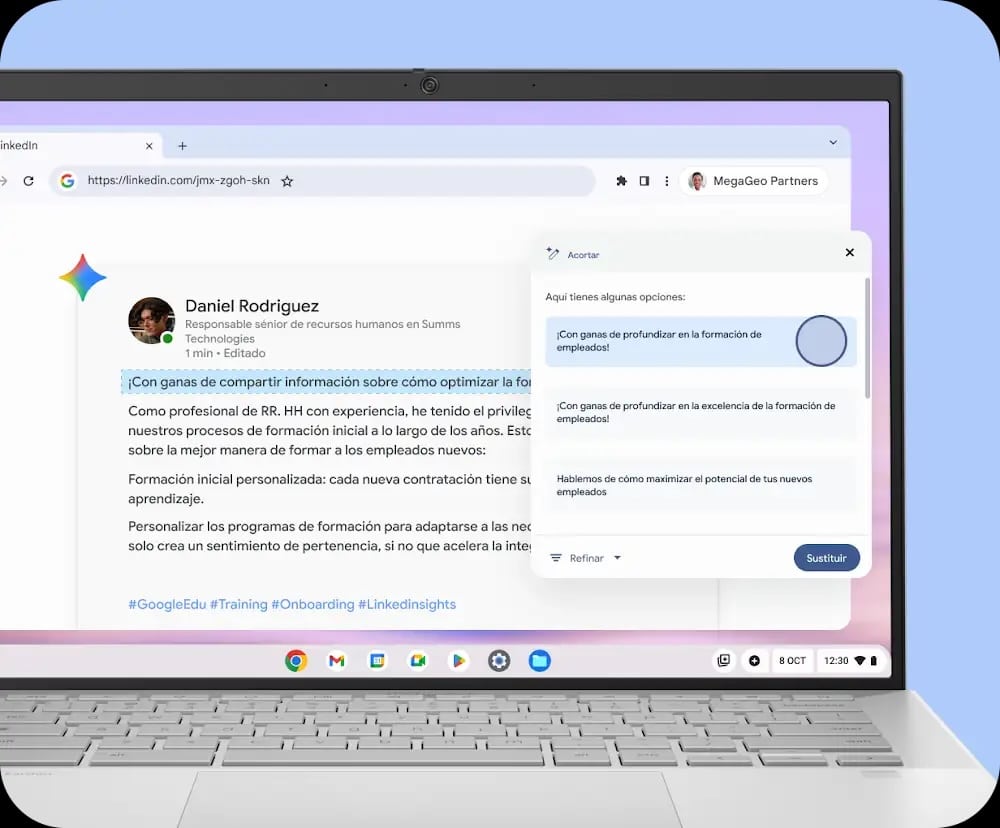Google’s next big move aims to eliminate fragmentation and boost cross-device innovation, using Gemini AI as the centerpiece for laptops, mobiles, and beyond.
Google has officially confirmed what had been mere rumors: the company is working to unify Chrome OS and Android into a single platform, a strategic move that redefines the future of its digital ecosystem. Sameer Samat, President of the Android Ecosystem, revealed this during an interview with TechRadar at Google I/O 2025.
A key step towards an integrated ecosystem
“We’re combining Chrome OS and Android into one platform,” Samat explained when asked about Apple device usage by the interviewer. His response was a clear statement of intent: Google wants to compete head-to-head with Apple’s closed and cohesive ecosystem, where iOS, macOS, and watchOS work almost symbiotically.
This merge not only aims to reduce development duplication—since engineers currently need to optimize apps for two separate systems—but also to create a smooth, consistent experience across phones, laptops, tablets, watches, and soon XR glasses.
From Chrome OS to Android, with shared DNA
Although specific technical details haven’t been disclosed, it appears that Chrome OS will migrate towards Android, not vice versa. This makes sense given that Android 16—officially introduced this year—already offers improvements for large screens, advanced window management, and greater app adaptability, which are essential for a desktop experience.
Additionally, with technologies like Trunk Stable and the new Android Drops, Google has shortened release cycles and delivered frequent updates even before its partners. This process will better synchronize the lifecycles of mobile and laptop devices.
Gemini: the intelligent heart of the new platform
Another major component of this unification is Gemini, Google’s AI assistant, which is poised to be the mature equivalent of Apple Intelligence. Gemini doesn’t just respond to commands; it analyzes web pages, summarizes YouTube videos, and can be integrated with the user’s visual context to provide multimodal real-time assistance.
During the interview, Samat demonstrated how Gemini helps with everyday tasks like buying a family car, summarizing complex information, or interacting with on-screen content through features like Circle to Search. All of this is deeply integrated into Android 16 and will be a core part of the unified platform.
What about Chromebooks?
A common question has been what will happen to current Chrome OS devices. While there’s no official confirmation, a gradual transition is expected that will allow manufacturers to adapt their products without impacting compatibility or updates. Some analysts speculate future Chromebooks might run on a modified Android or that Android will incorporate key Chrome OS desktop features, such as window management or file system elements.
The Apple model as a mirror (and rival)
With this strategy, Google is following Apple’s example—building a robust, closed ecosystem where devices communicate seamlessly. However, Google’s advantage lies in its openness, as its platform is present on over 3 billion Android devices worldwide, including smartphones, smart TVs, watches, cars, and now XR glasses and laptops.
The merger could also accelerate immersive experiences like Android XR, the extended reality system Google is developing with Samsung. Samat hinted that Google’s new wearables will be designed to leverage both AI and integration with Android devices.
A converging future
This unification comes at a pivotal moment. Android 16 is already available from day one on the new Samsung Galaxy Z Fold 7—a rare feat—and with Apple pushing to release its own foldable iPhone or enhance Siri with generative AI, Google recognizes that the tech battle increasingly hinges on integration rather than just innovation.
Samat was clear: “People see the future first on Android.” With Gemini, Android XR, and a new platform blending desktop and mobile strengths, Google is betting on a future where AI and device convergence become the core of the user experience.
What does this mean for users?
– More device consistency: smoother transitions from phone to laptop with synchronized apps and functions.
– Unified development: developers can create apps that work seamlessly across environments without doubling their efforts.
– AI prominence: Gemini will be available on all devices, assisting with both everyday and complex tasks.
– Possibly the end of Chrome OS as we know it: Although transition plans are gradual, the current dominant system in U.S. education could eventually fade away.
In summary
Google’s move to unify Chrome OS and Android marks a significant milestone. The goal: create a seamless, smart, open ecosystem that competes effectively with Apple. While detailed technical steps and timelines are still to be announced, this shift appears inevitable and strategically motivated.
With Gemini as an assistant, Android as its foundation, and a focus on large-screen devices, Google’s future is less about mobility and more about convergence.

